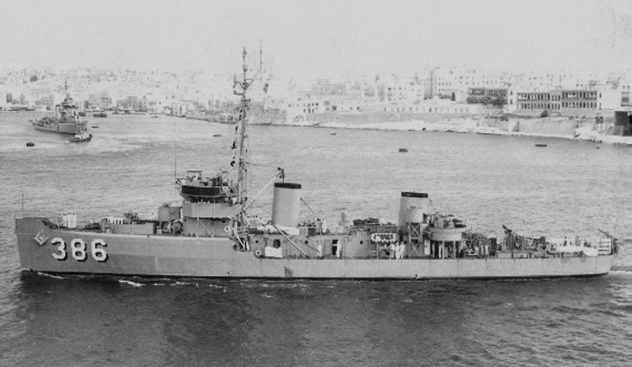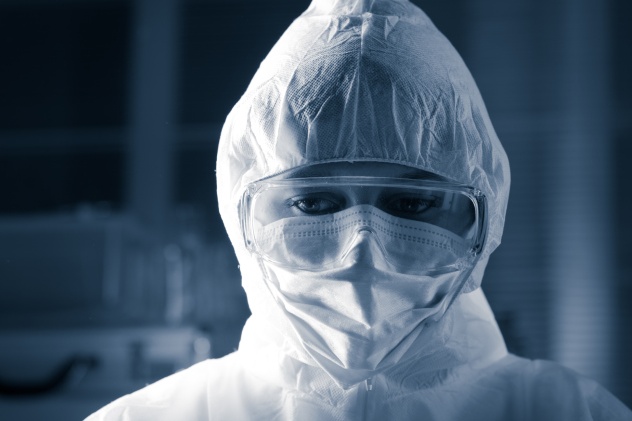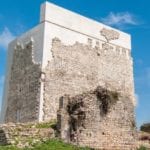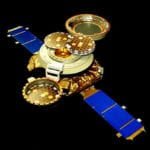 Creepy
Creepy  Creepy
Creepy  Movies and TV
Movies and TV 10 Movies That Get Elite Jobs Right, According to Experts
 Weird Stuff
Weird Stuff 10 Times Real Laws Were Based on Bizarre Hypotheticals
 Animals
Animals 10 Inspiring Tales of Horses Being Human
 Mysteries
Mysteries Top 10 Haunting Facts About the Ghost Ship MV Alta
 History
History 10 Surprising Stories About the Texas Rangers
 Humans
Humans 10 Philosophers Who Were Driven Mad by Their Own Theories
 Miscellaneous
Miscellaneous 10 Video-Game-Worthy Weapons and Armors from History
 Weird Stuff
Weird Stuff 10 Psychics Who Accurately Predicted Wartime Events
 The Arts
The Arts 10 Pieces of Art Inspired by a Broken Heart
 Creepy
Creepy 10 Death Superstitions That Will Give You the Creeps
 Movies and TV
Movies and TV 10 Movies That Get Elite Jobs Right, According to Experts
 Weird Stuff
Weird Stuff 10 Times Real Laws Were Based on Bizarre Hypotheticals
Who's Behind Listverse?

Jamie Frater
Head Editor
Jamie founded Listverse due to an insatiable desire to share fascinating, obscure, and bizarre facts. He has been a guest speaker on numerous national radio and television stations and is a five time published author.
More About Us Animals
Animals 10 Inspiring Tales of Horses Being Human
 Mysteries
Mysteries Top 10 Haunting Facts About the Ghost Ship MV Alta
 History
History 10 Surprising Stories About the Texas Rangers
 Humans
Humans 10 Philosophers Who Were Driven Mad by Their Own Theories
 Miscellaneous
Miscellaneous 10 Video-Game-Worthy Weapons and Armors from History
 Weird Stuff
Weird Stuff 10 Psychics Who Accurately Predicted Wartime Events
 The Arts
The Arts 10 Pieces of Art Inspired by a Broken Heart
10 Terrifying US Government Projects Carried Out On Domestic Soil
There’s no doubt that the US government, as well as governments around the world, are into some pretty shady stuff. One of the most notorious US government operations is probably MKULTRA, which was the blanket name for the CIA’s attempts at mass mind control. That’s far from the only questionable—and frankly terrifying—government project that has been done on American soil.
10 Operation Big Itch

Dugway Proving Ground (DPG) in Utah was established as a military installation with the reallocation of public lands in 1942. By the 1950s, there was a definite need for a remote testing facility, a role that DPG would fill nicely. It became the location of the Biological Warfare Assessment Laboratories in 1954. With that title came the necessity of figuring out whether or not insects were viable for use as delivery systems for various types of nasty diseases. Specifically, they wanted to know if they could deliver the plague via fleas.
Operation Big Itch dropped countless fleas on the Utah desert. Cages of guinea pigs were set up on the ground to gauge how successful the drop was, as there were concerns about whether or not the fleas would survive and how much they would spread if they made it to the ground. The fleas were sealed in containers that were designed to rupture with the firing of a CO2 cartridge at an altitude of 300–600 meters (1,000–2,000 ft).
The experiment was something of a success. The guinea pigs became infested with the fleas, but it was also decided that it was necessary to drop the fleas close to the target to make sure that the bugs made it to their hosts. Not all of the drops went off flawlessly. In one attempt, one of the cartridges fired while it was still in the plane, and the crew was swarmed by fleas.
Overall, the test was enough of a success that there were plans in the works to build a massive flea-breeding facility that would raise 50 million fleas a week. Producing enough plague virus for all of those fleas wasn’t as easy, however. When researchers failed in their attempts to figure out how to do so, the plan fell by the wayside.
9 Operation Plumbbob
Between May 28 and October 7, 1957, military personnel were exposed to 29 nuclear tests in order to gauge their response after being near to and witnessing a detonation. At the time, it seemed quite likely that the world would end up in a full, no-holds-barred nuclear war. In order to make sure that military personnel could still function after the shock of the blast, Operation Plumbbob was performed on a group of men based in Fort Bragg, who were designated as “Task Force Big Bang.”
The 167 men of the task force were sent to Nevada, where they were familiarized with the weapons and safety measures throughout August. Slated to leave Nevada on September 5, the test, code-named Shot Galileo, was carried out on September 2. In theory, it was pretty simple. The men would watch the nuclear explosion and then disassemble and reassemble their rifles. After that, they would run a course through a minefield and infiltration course (including obstacles like barriers, walls, and foxholes), and their results would be compared to how they did without the nuclear factor.
The blast was detonated, the course was run, and the men were decontaminated. Bizarrely, the psychological evaluation ended up being of little to no use. Prior to running the course, the men had already been exposed to a nuclear detonation—Shot Smoky, on August 31. Since the whole point was to see how personnel responded when they were forced into a situation that they had never been in before, none of the results were particularly useful.
Other parts of Operation Plumbbob included testing warhead designs, as well as seeing how military and civilian buildings could—or couldn’t—withstand a nuclear explosion. In one experiment, 1,200 pigs were caged and dressed with various protective coverings to see which one would protect them best. Most survived the thermal blast, but most were also covered with third-degree burns. Later, an examination of the men involved in the operation (over 16,000 throughout the course of the program) found that there was an unnaturally high rate of leukemia due to the extreme levels of radiation that they had been exposed to.
8 Ghetto Informant Program

The Ghetto Informant Program was a nationwide surveillance program instituted by J. Edgar Hoover in 1967. Hoover was convinced that race riots were on the verge of destroying communities everywhere and that they were brewing in the country’s ghettos. (He also thought the Russians were probably involved somehow.) FBI field offices became responsible for establishing “ghetto listening posts,” a term for individuals who could be counted on to report on any unrest in neighborhoods designated as “ghetto-type areas.”
Once these so-called agents were recruited, they were told to go into “Afro-American type book stores” and identify those with their finger on the pulse of the neighborhood. They kept tabs on gang activity, followed ex-convicts, and would, theoretically, warn the FBI if anything was about to go down.
In the end, there were never any warnings, and there was never anything to report. When riots did happen, like those that seized the nation after the murder of Martin Luther King, Jr., the FBI was still completely unprepared. Possibly adding to the failure of the program was the fact that it was considered critically important that agents recruit a certain number of informants, and they would be reprimanded if they didn’t meet their quota. Faced with that, many created false informants out of thin air. At the same time these fictional informants were filing equally fictional reports, New York City went overboard in the opposite direction, forming a “racial squad.” By the time the whole program was eliminated, there were 7,500 official ghetto informants, each of whom was receiving payment from the government for their contributions.
7 Operation Minaret

It wasn’t until 2013 that a certain list of names was finally revealed to the public. It had been known since the 1970s that the NSA was spying on those who they thought were threats, especially throughout the Vietnam War years. The recently declassified documents don’t just list names, but also testimonies from the NSA’s own agents, who acknowledged that what they were being asked to do wasn’t just morally wrong, it was mostly illegal, as well.
The ultimate goal of Operation Minaret was to see where anti-war sentiments were really coming from and if there were agencies outside the US that might have been encouraging the civil unrest. Before Operation Minaret ended in 1973—just as Watergate was kicking off—phones belonging to big names like Martin Luther King Jr. and Muhammad Ali (who was under surveillance for almost six years), as well as journalists from the New York Times and Washington Post, were tapped. Government officials weren’t above the intrusion, either, with several senators also making the watch list.
Reports drafted from the operation’s findings were suspiciously discreet, printed on paper without NSA identification and being delivered directly and only to the presidents (first Johnson, then Nixon) themselves. A total of around 1,650 names were on the surveillance watch list. While it’s most notably been used to track the movements and conversations of outspoken anti-war individuals, that’s not what it was originally intended for. When it started, Operation Minaret was supposed to be used for tracking terrorists and drug traffickers.
6 Operations DEW I And DEW II

Biological weapons have always been a pretty frightening idea. In 1952, the US Army wanted to know just how a potential biological contaminant released above US soil would spread.
So, they released one.
Operation DEW I encompassed a test area over North and South Carolina and Georgia. Doses of zinc cadmium sulfide (ZnCdS) were released in five trials from the USS Tercel. The ship ran a parallel course along the coast 8–16 kilometers (5–10 mi) out, and although the first trial’s contaminants were swept out to sea, the aerosol releases in the other four trials went up to 280 kilometers (175 mi) inland across all three states. DEW II released spores from Lycopodium, a type of fern.
DEW I wasn’t the only time that the Army played with with zinc cadmium sulfide, either. Similar batches were released over Minneapolis, St. Louis, Corpus Christi, Fort Wayne, and as many as 29 other locations across the US. ZnCdS was used for a few different reasons. It was generally accepted as safe for humans, plants, and animals. It was affordable, it would disperse like a biological weapon, and it was cheap. ZnCdS also shows up under UV light, which made it easy to see where it ended up.
Needless to say, people were rather outraged when it was found that they’d been test subjects in a mock biological weapon strike. A subcommittee was put together to asses whether or not ZnCdS was harmless as the Army claimed. Basic results of experiments like feeding the compound to rats suggested that it was harmless, but the subcommittee recommended that the Army had better go back and run some more tests because they weren’t sure what the ultimate effects of the compound really were, especially when it was inhaled in any quantity. The cadmium that was released was of particular concern because of its known carcinogenic properties and association with lung cancer. Ultimately, it was decided that those who were exposed to the tests had only a minimal chance of developing respiratory problems or lung cancer.
5 Project 112 And Project SHAD

In 2002, the US military started reaching out to veterans who may have been involved in Project 112 or Project SHAD. Both operations involved exposing personnel to substances chosen to act as stand-ins for biological weapons, allowing researchers to see how they spread. Project 112 was done at the Deseret Test Center in Utah in a series of tests from 1962–73, and Project SHAD (Shipboard Hazard and Defense) was done aboard warships in waters around the world.
The details of the project might have remained under wraps for much longer than they did if it wasn’t for the Department of Veteran Affairs requesting an investigation into the operations, as well as information on whether or not service members’ health may have been compromised. Nearly 6,000 people, both military personnel and Department of Defense civilian staff, were exposed to the tests, with and without knowledge. When information about the tests was released, it was thought that the agents released were harmless. However, it was also stressed that veterans with concerns should come forward and that it was acceptable to reveal information about dates, places, and possible side effects with health care providers.
There’s a long list of biological agents that the test subjects were exposed to, including Coxiella burnetii (Q fever) and staphylococcal enterotoxin B (which causes food poisoning). They also used some pretty horrific nerve toxins, including sarin (now classified as a weapon of mass destruction) and soman (a clear, colorless liquid that can cause death in minutes). Both can be fatal if only the tiniest amount gets on the skin.
4 Projects CHAOS, MERRIMAC, And RESISTANCE

Projects CHAOS, MERRIMAC, and RESISTANCE all had the same basic end goal—to spy on US citizens and collect information about potential threats to national security and to CIA activities.
CHAOS began in 1967 and was mainly tasked with assessing the amount of foreign influence being leveraged on American soil, specifically in anti-war protest groups and civil rights groups. The project came to an end in 1974, after reporting to the highest levels of the government that they hadn’t found any signs that a foreign power was trying to stir up trouble at home. Those reports were largely dismissed as inaccurate. With more and more pressure to find something, CHAOS began spying on a wider group of Americans, even following those who went abroad. There, the program did claim to uncover information about people who participated in protests and organized marches in the states, doing it to gain credibility as the sort of person who will get things done, ultimately in order to join up with foreign radicals.
MERRIMAC specifically targeted civil rights groups and peace groups operating in Washington, DC, with the goal of giving the CIA and law enforcement a heads-up when protests were going to happen. Gradually, the net was cast a little wider, investigating the paper trail behind where the groups were getting their funding from, as well as investigating group leaders.
RESISTANCE was established to safeguard the CIA’s own assets. Operatives used everything from news reported in daily newspapers to information funneled through police departments and authorities on college campuses to determine when and where there was likely to be action taken against CIA buildings or operatives.
RESISTANCE and MERRIMAC both reported to CHAOS. Under the program, a mind-blowing number of individuals were investigated, going as far as monitoring mail, tapping phones, breaking and entering into homes, and physical surveillance.
3 Operation Whitecoat
No one was ever sure what to do with conscientious objectors during wartime. In England, a group of them was shipped off to the countryside and exposed to all sorts of nasty things from starvation to scabies, all in the name of helping the men on the front lines.
That sounds barbaric, right? Well, the US was doing the same thing under an operation that hinged on a deal made with the Seventh-day Adventist Church. From 1954–73, more than 2,000 church volunteers headed to military installations for participation in Operation Whitecoat. The volunteers were filed into a series of rooms no bigger than a telephone booth. Each room had a gas mask connected to a central sphere that was ominously called the Eight Ball. Inside the sphere were the pathogens, and to be contaminated, all the volunteers needed to do was to put on the mask and breathe. Vaccines were also being tested, which at least meant that as soon as volunteers started feeling sick, they were given medical treatment.
Many of the volunteers are still alive today, and many seem to have no regrets about their participation. No one died during the testing period, but it’s uncertain what happened to all of them afterward. At least a few people have suffered from chronic health issues after their time as a whitecoat, including Gene Crosby, who’s had a lifetime of problems so bad that in 2003, he told PBS that he wished he’d taken his chances on the front lines.
One of the most common viruses that the volunteers were exposed to was Q fever (the same virus that was released over the US in Project 112). Some volunteers were subjected to multiple diseases, from the black plague to the potentially deadly tularemia.
2 Project Thor (aka Rods From God)
Project Thor was never put into practice, but if it had been, the results might have been absolutely terrifying. In the 1950s, scientist (and future sci-fi writer) Jerry Pournelle was looking at the idea of kinetic bombardment, which means launching missiles from space with no explosives and simply letting the power of speed and gravity do the work. If you’ve played Call of Duty: Ghosts, the idea might sound familiar. It’s the opening scene, and it was almost very real.
Project Thor (or Rods from God) never made it off the drawing board, thanks in no small part to the Outer Space Treaty of 1967, which made space-based weapons off-limits. Until then, the military was looking at ways to make satellites into incredibly deadly weapons. We may eventually see such ideas make the jump from science fiction to reality, though, especially with advancing technology and a shift in the position of whether or not space is a staging ground.
The basics of the idea involve two satellites working together. One is armed with 6-meter-long (20 ft) tungsten rods, no more than 0.3 meters (1 ft) in diameter. The second satellite does all of the communication and targeting. After a rod is dropped, it’s estimated that it would be traveling at 11,000 meters per second (36,000 ft/s) when it finally hits the ground.
We don’t know much else about the plan, except that the government’s not saying what the project’s current status is. Attaching the rods to intercontinental ballistic missiles was also suggested, which would be cheaper than using satellites. We might still see Rods from God dropping from US satellites some day.
1 Project ARTICHOKE
Even the NSA’s archives and security research staff only have bits and pieces of what’s been called Project ARTICHOKE. It’s mentioned in the same context as MKULTRA, and it involved experiments using so-called “special interrogation techniques.” It’s been uncovered that experiments with hypnosis were conducted through the 1950s, and at least six volunteers were found to have been subjected to experiments on the psychological impact of total isolation. Even declassified documents from the CIA indicate that they’re not sure of just how often some of these “special” techniques were used in the field, but they also note that it’s probably more often than their records indicate.
Buried in the memos is a bizarre mention of using assassins who are hypnotized into killing. If it sounds familiar, it’s the plot of The Manchurian Candidate—and the US was really trying to do it. Central to the CIA memo was trying to figure out whether or not it was possible to take someone (whose name and nationality are redacted) already in custody and program them to kill. The memo states that the person had originally been acting on the behalf of the government but had become less willing, so they were looking for another option. There was debate over whether it would be effective to slip something into the person’s drink (as they were a noted heavy drinker) and then to hypnotize them to assassinate another target. The plan would wrap itself up, leaving not only the target dead, but the assassin (who would remember nothing) arrested and, as the memo states, “disposed of.”
Ultimately, the CIA determined that it just wasn’t possible to hypnotize someone into being an assassin, although just how they came to that conclusion has yet to surface.








